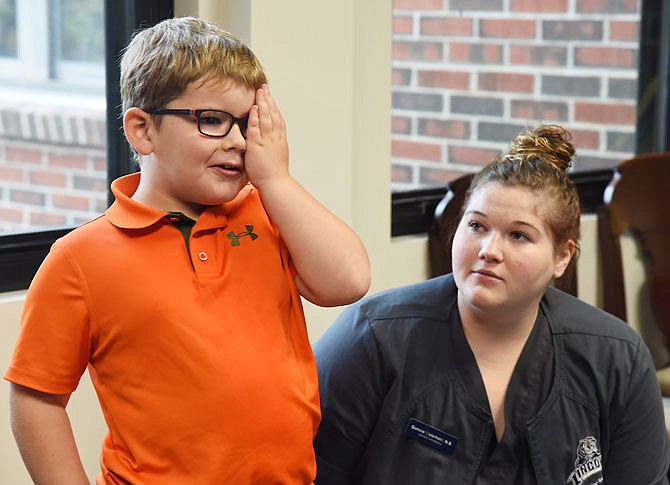The preliminary diagnosis for a new partnership between Lincoln University and St. Martin School seemed to be good Thursday, after LU nursing students provided preliminary health screenings and education for St. Martin's students.
St. Martin Principal Eddie Mulholland reached out to LU, and the two schools met over the summer to evaluate what it would take for LU nursing students to perform the services Mulholland said have been done by parent volunteers up to this point.
Junior-level LU nursing students provided all 230 or so St. Martin students in attendance Thursday with preliminary screenings to look for possible hearing and vision deficiencies. The LU students also took measurements of students' height and weight.
Mulholland noted Thursday's screening is not a one-time event but the beginning of a relationship; LU will provide health screenings once in the fall and then again in the spring.
"The nursing students are having a ball," Vicky Becherer said. She is an associate professor of nursing at LU, and she co-teaches the course "Nursing of Women and Children." The course has classroom and clinical work.
LU's School of Nursing Dean Ann Marie McSwain said St. Martin is the first school with which they've partnered. Students in the women and children nursing class need 96 hours of hands-on experience, and students in the program need about 800 hours of hands-on experience in total to get their RN-BSN certification.
McSwain said LU nursing students already do hands-on learning at hospitals in Fulton, Columbia and Jefferson City, but she added, "we'd like to have more partnerships."
"It's sort of a symbiotic relationship," assistant professor of nursing Abbie Bredeman explained of the mutual benefits of the school children getting preventative care and the nursing students getting hands-on experience with real patients. Bredeman is the other co-teacher of the women and children nursing class. She covers the obstetrics portion of the class, and Becherer covers pediatrics.
"Us interacting with all ages is good," nursing student Meghan Nappier said of how hands-on learning with school-age children is particularly helpful.
Brooke Craw said it's helpful to see nursing in the real world compared to a textbook. Classmate Terica Kelly added "you can't say the same words" with some of the younger children as opposed to the older ones; interaction with different age-groups forces nursing students to learn how to come up with the right language to help their patients grasp what's going on.
Becherer added her students also learned it takes more patience to interact with younger patients.
"It's always good to have a visual aid," Kelly added. Set up around a central room Thursday were poster boards displaying information for children about water and burn safety, oral health and healthy eating. Students also saw age-appropriate educational videos.
Nursing student Olivia Clarke said one of the useful things students learned was dancing can be a form of exercise.
Some students also learned how to use a fire extinguisher as part of information about fire safety.
A letter to St. Martin parents and guardians noted while the health screenings provided Thursday can highlight concerns, no diagnoses could be provided. Children with concerns should be "further checked with a healthcare provider, such as an eye doctor or the child's pediatrician." The letter also noted screenings are not meant to replace any sort of routine check-ups children get.

